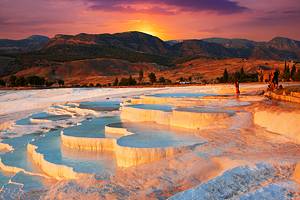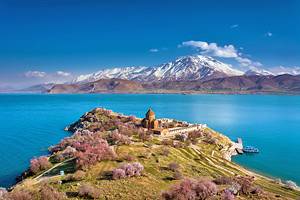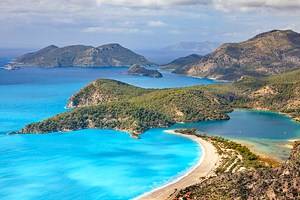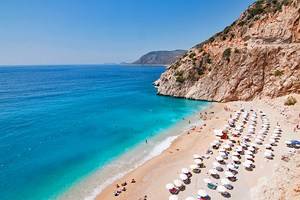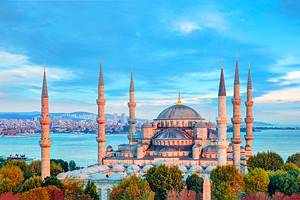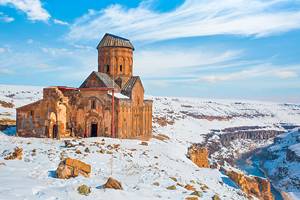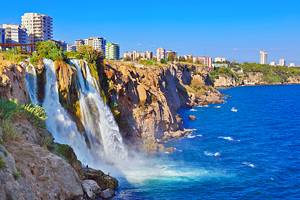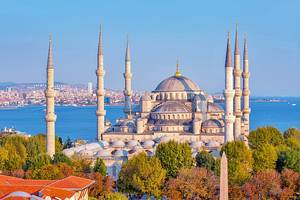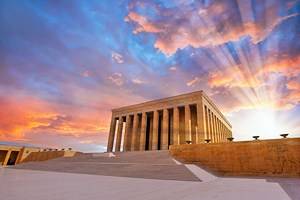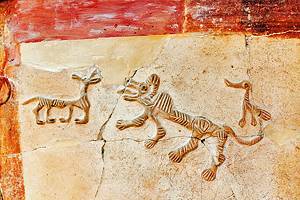Plan Your Trip to Turkey: Itineraries
Turkey swoops from Mediterranean shore to vast mountain ranges and rugged, rock-pitted high plateau, and has been settled since the early days of human history, so it's no wonder planning an itinerary here can prove tricky.
From ancient sites that inspired legends to the cities of grand empires, Turkey simply has too many things to see and do on just one trip.
To cut down on wearying travel time and internal flights, if you have 10 days or less up your sleeve, it's easiest to concentrate on one region. This allows you to slow down and explore rather than spending your vacation rushing everywhere.
Turkey's public transport system is world-class. The bus network, in particular, is extensive. Except for the most out-of-the-way ancient sites, travel itineraries for Turkey can be easily pulled together solely using public transport. If you want to rent a car for the added freedom and speed, road conditions and signage are excellent.
Find inspiration with our list of the top Turkey itineraries.
Aegean Adventure Itinerary

Aegean Adventure Highlights: Istanbul, Gallipoli, Troy, Pergamum, Ephesus, Pamukkale
This classic 7-day itinerary, which can easily be traveled solely using public bus, hits Turkey's most feted archaeological sites as it scoots south down the Aegean coast.
It's the perfect first-timer trip, taking in both Istanbul's mind-boggling glut of historical monuments and the country's three most famous UNESCO World Heritage Sites.
Give yourself at least two days in Istanbul, Turkey's major metropolis. This allows you to focus on major sights, including the Hagia Sophia, Topkapı Palace, and the Grand Bazaar on Day One before taking to the water on Day Two for one of Istanbul's most iconic experiences: a cruise upon the Bosphorus Strait.
From Istanbul head west, through the sunflower fields of eastern Thrace, to the attractions of the Gallipoli Peninsula. The WWI battlefields here are where Atatürk (the founder of modern Turkey) first rose to prominence as the Ottoman army held back the Allied forces in one of the war's bloodiest episodes.
Stay directly across the water from the peninsula in the buzzy city of Çanakkale. This is the best base for visiting both Gallipoli and the much mythologized ruins of Troy.
Luckily, if you're short on time, Çanakkale tour operators offer day trips that encompass a morning tour of major tourist attractions like the Gallipoli Peninsula's battlefields, war memorials, and cemeteries and an afternoon spent exploring Troy.
Afterwards, travel down the Aegean Coast to Bergama. This easygoing small town is overlooked by the hilltop remnants of Pergamum, one of Turkey's grandest ancient city ruins and a UNESCO World Heritage Site.

Pergamum's Acropolis and Asclepeion (healing temple) are just a taster for what's next, as now you're heading south to Selçuk and Ephesus – the greatest ruins of them all.
Selçuk is a charming red-tile roofed village with a Roman aqueduct running straight through the center of town. Even if Ephesus wasn't right next door (which it is), you'd want to stop here for its laid-back atmosphere and handful of historic buildings scattered through the lanes.
It is worthwhile spending an extra day here, though, to explore Selçuk's Basilica of St. John and Ayasuluk Fortress. Tourists can also go sightseeing out of town at the Meryemana, where local legend claims the Virgin Mary lived out her later years.
UNESCO World Heritage Site Ephesus will take up much of your time, and beach lovers may want to explore the port town of Kuşadası while in the area, just 18 kilometers from the Ephesus ruins.
You're going to head inland after Selçuk, through the coastal plains to visit Pamukkale, your last UNESCO World Heritage Site and the final stop on this itinerary. Pamukkale's hill of gleaming white calcite travertine terraces, topped by the rambling ruins of the Roman spa-town of Hierapolis, is a natural wonder and archaeological site all-in-one.
Pamukkale is also the best base for day trips to the nearby Roman ruins of Laodikeia and Afrodisias.
Sitting on top of Pamukkale's travertines, watching sunset cast a rosy glow over the terraces, is a suitably dramatic end to this week-long romp through Turkey's most acclaimed sights.
Add On: Direct buses linking Denizli (the nearest big city to Pamukkale) to Cappadocia make it easy to tag the Cappadocia itinerary onto this trip.
Got more time? Bus from Denizli direct down to explore Antalya and then follow the Beaches & Ruins of the Turquoise Coast itinerary, backwards up the coast to Fethiye's many seaside charms.
Beaches & Ruins of the Turquoise Coast

Beaches & Ruins of the Turquoise Coast Highlights: Paragliding at Ölüdeniz, Lycian city ruins, Patara Beach, Kaş, Kekova Island, Çıralı, Antalya
The quintessential Mediterranean journey, this route along what is often called the Turquoise Coast takes in Turkey's most stunning slice of shoreline, a bag full of ancient Lycian sites and plenty of things to do both on and off the beach.
Plan for 10 days but factor in a few more if you want to add in time at some of Turkey's best beaches.
It's easy to get around between towns using public bus services, but to tick off all four Lycian city sites on the route between Fethiye and Patara, you'd need to rent a car. Otherwise, use Fethiye or Patara as your base.
Fethiye, with its harbor opening out onto an island-speckled bay, is the springboard to this region. While in town head out on the water for a boat day trip, visit the ruins of Kayaköy and tandem paraglide over Ölüdeniz; it's one of the top things to do here.
From Fethiye, spend a day ruin-hopping through the hills as you head down the coast to Patara Beach, home to Turkey's longest strip of sand. Four of the major Lycian ancient city sites – Tlos, Pınara, Xanthos and Letoön – lie along, or just off, this route.

Patara Beach itself is rimmed by the ruins of Ancient Patara, once one of Lycia's major ports and birthplace of St. Nicholas (aka Santa Claus). Spend the night in the itsy village of Gelemiş which backs the beach and ruins.
Heading farther down the coast is the action-adventure town of Kaş. Stop at famous Kaputaş Beach, squeezed between high cliffs, along the way.
Kaş tour operators could keep you busy for days. Things to do while in Kas include sea kayaking to the sunken city ruins of Kalkan Island, diving trips, hiking, and boat tours — all to tempt you to extend your stay.
After Kaş, it's time for the beach, so keep moving west to Çıralı. On the way, stop off at Demre to see the ruins of Ancient Myra and the Church of St. Nicholas. It was the saint's charitable exploits as Bishop of Myra in the 4th century that created the Santa Claus myth.
Çıralı is among Turkey's best beach towns, and also on of its most laid-back. If you want more than the sand though, it's also the best base from which to visit the eternal flame of the Chimaera and the ruins of Ancient Olympos nearby.
When you're finished with the sand, it's only a short hop to your last stop at Antalya, with its historic old town district; beaches; and plentiful day trip options to big-hitter Roman sites such as Aspendos, Perge, and Side.
Add On: Jump on a bus from Antalya to Pamukkale and follow the Aegean Adventure itinerary backwards all the way up to Istanbul.
With direct buses between Antalya and Cappadocia, it's also easy to combine this coastal route with the short Cappadocia itinerary.
Capitals of Empire

Capitals of Empire Highlights: Istanbul, Bursa, Konya, Museum of Anatolian Civilizations, Hattuşa, Amasya, Safranbolu
Looping through central Anatolia, this itinerary stars some of Turkey's most important historical cities.
Although most of it can easily be done using a combination of public bus, ferry and train, a rental car is handy for the Ankara-Safranbolu leg and cuts down travel time substantially.
Not counting time spent in Istanbul, this route takes between 8 and 10 days.
Begin in the grandest city of them all: Istanbul, capital of both the Byzantine and Ottoman Empires. From here, jump on a ferry across the Marmara Sea to head to Bursa.
Bursa is an old Silk Route trading post and became the Ottoman Empire's first capital. Delve into this city's grandest era touring Bursa's attractions, which include its intricately tiled mosques, the ornate tombs of the early sultans inside the Muradiye Complex, and the vast bazaar area.
Take the bus southeast from here to Konya, 12th-century capital of the Seljuk Sultanate of Rum and home of the whirling dervishes. Don't miss the Mevlana Museum and try to time your visit to catch the weekly whirling dervish ceremony; it's one of the top attractions in Konya.
From Konya, it's also an easy half-day trip to the archaeological site of Çatalhöyük, the world's largest Neolithic village ever discovered.
Heading north now, hop on the train to Ankara. If you start off early enough, you'll be able to stop-off in Polatlı along the way, and from the train station there, take a taxi-tour to the Iron Age Phrygian capital of Gordion.

Once in modern Turkey's capital, make sure to visit at least two top Ankara sites: the Atatürk's mausoleum at the Anıtkabir and the Museum of Anatolian Civilizations, which will give you a crash course in Anatolia's history from the Neolithic to Iron Age.
Traveling the next section is more straightforward and quick by car. It does work, though, using public transport if you have more time up your sleeve to wait for connections, and are comfortable hopping between a blend of both bus and local dolmuş (minibus) routes.
Having seen the glorious treasures of the Hittite Empire in Ankara's museum, now head a couple of hours east to the ruins of their Bronze Age capital Hattuşa. The area around Hattuşa has plenty more historic tourist attractions to explore, and those with an interest in Turkish history may well want to stay a night.
From here push farther northeast to Amasya. The tiny riverside old town district here is full of preserved wooden Ottoman-era mansions, many of which are now atmospheric restaurants, cafés, and boutique hotels. The high cliff behind is honeycombed with the tombs of the Pontic Kings, who made Amasya capital of the Kingdom of Pontus in the 3rd Century BC.
Amasya's chief tourist attraction is its heritage ambience, but do visit the Sultan Beyazıt II Mosque for its astonishingly beautiful interior, and the Amasya Museum while in town.
Turning west, Safranbolu is the last stop on the itinerary and the only one that has never been a capital.
Safranbolu is so quaint, it looks like it fell out of a storybook. This old trade route town is famous for its old town, replete with cobblestone alleyways crammed with finely restored timber and red-tile roofed Ottoman mansions. Once home to wealthy traders and merchants, today these grand houses now function as cafés, restaurants, and boutique hotels.
After soaking up the highlights of Safranbolu, you can either drive back to Ankara to drop off the hire car or take a direct bus back to Istanbul.
Add On: If you have around 20 days to explore Turkey, when you get back to Istanbul, head down the coast on the Aegean Adventure itinerary.
Cappadocia Itinerary

Cappadocia Itinerary Highlights: Hot-air ballooning, Rose & Red Valley hiking, Göreme Open-Air Museum, Zelve Open-Air Museum, Ihlara Valley
Bang in the center of Turkey, Cappadocia's moonscape valleys, studded with the cone and pillar hoodoos known locally as "fairy chimneys," is one of the country's most famous landscapes and among Turkey's most beautiful places to photograph.
This is also one of the best places to visit in the country for outdoor activities. Fantastic day hikes and horse rides are right on the doorstep here, while Cappadocia's hot-air ballooning is world famous.
An extra bonus is that because of the Cappadocia region's small size, there's no need to move hotels. Base yourself just in one village and explore on day trips.
This 3-day Cappadocia itinerary samples the highlights of the region and can easily be tacked on to any of the other Turkey itineraries on this list.

On Day One in Cappadocia hit the most famous sight first: The mid-Byzantine-era frescoes inside the cluster of cave-churches known as Göreme Open-Air Museum are what first put this area on the tourism map.
Spend the rest of the day amid the surrounding lunar landscapes of the valleys. For the most scenic trail, hike from Göreme through Red and Rose Valleys to Çavuşin.
If you want to do a hot-air balloon tour, you'll have to get a pre-dawn start the next day. The bonus to this early morning wake up is that you still have a full day in front of you afterwards.
Spend Day Two first exploring the fairy chimneys of Paşabağı and then the three interconnecting valleys of Zelve Open-Air Museum, with its mammoth conical rocks and abandoned village remnants. Head to Avanos for lunch and then a stroll around the pottery workshops, then head to either Ortahisar or Uçhisar to climb up to the top of these villages' rock-citadels and explore the cobblestone alleys.
On Day Three, book one of the many day tours to Cappadocia's more outlying attractions that tour operators in Göreme offer. The most popular option is the tour that heads to Cappadocia's south, taking in the caverns and tunnels of Kaymaklı Underground City, where Byzantine inhabitants hid during the Arab raids of the 6th and 7th centuries, and then Ihlara Valley, with its high cliffs riddled with cave-churches.
Add On: Extend the Exploring the Southeast itinerary by three days by starting from Cappadocia. From Nevşehir (the main bus station in the Cappadocia area), there are daily buses to Antakya.
Exploring the Southeast of Turkey

Exploring the Southeast Highlights: Hatay Archaeology Museum, baklava in Gazıantep, Mount Nemrut, Şanlıurfa, Göbeklitepe, Mardın
Turkey's southeast offers rugged mountain and high plateau scenery, historic cities, and some of the country's most interesting archaeological sites and world-class museums.
Plan on at least 7 to 8 days for this itinerary, though you'd need a rental car to complete it at that rate, and 10 days gives you more time to explore. Public buses can get you everywhere except Mount Nemrut on this journey.
Begin in Antakya (Biblical Antioch), where the Hatay Archaeology Museum holds one of the world's most renowned mosaic collections, and you can visit the Church of St. Peter, where some of the earliest Christian converts once gathered.

Head east from here to see the highlights of Gaziantep, Turkey's baklava capital. After strolling the bazaars and eating your way through the historic patisseries in the old town district, visit the Gaziantep Zeugma Mosaic Museum for more mosaic mastery.
It's now time to zip north into the mountains to visit the eerie stone heads atop the barren summit of Mount Nemrut. After the main summit site, make sure to visit the sites scattered along the slopes of Mount Nemrut on the drive back down, for their stunning views, as well as the ruins, particularly Arsameia.
From Mount Nemrut, travel south to the bustling pilgrimage city of Şanlıurfa, once ancient Edessa.
Most visitors come here today to visit the Neolithic temple T-pillars of Göbeklitepe, Turkey's newest UNESCO World Heritage Site.
Şanlıurfa's attractions are worth a few days of your time. The old town bazaar district is a fascinating place to visit, while Şanlıurfa Archaeology Museum is a dazzling journey through the dawn of human culture. This is also the best base from which to day trip to the mudbrick beehive houses and other historic attractions of Harran.
Finish up in the historic hillside town of Mardin. End your journey by getting lost amid the steep, mazy streets of Mardin's heritage buildings, ancient churches, and mosques and then soaking up the sunset vistas across the Mesopotamian Plains.
Add On: Mardin's airport has regular flights to Istanbul, so with more time, you can easily combine this trip with one of the coastal itineraries.
Southern Mediterranean

Southern Mediterranean Highlights: Aspendos and Perge; Alanya Castle; Anamurium; Kızkalesi ruins; Tarsus old town
Turkey's southern corner of the Mediterranean is less visited by foreign tourists but is home to plenty of historic attractions, castles, classical-era ruins, and coastal scenery.
Plan around eight days for this itinerary if you have your own vehicle and at least 10 if you're traveling using public transport. All of the main stops on this journey are linked by regular buses, though taxis will be necessary for some trips to the ruins.
Start your sightseeing in Antalya and plan to spend at least two days (more if possible) for side trips to the classical-era ruins of Aspendos, Perge, and Termessos.
From Antalya head southeast to Side, a resort destination with a glut of Roman ruins right in town, and then farther south to the attractions of Alanya, where the harbor-front is framed by Seljuk-era fortifications and the hillside is home to an old town district cradled within ancient castle walls.
Antalya, Side, and Alanya are all beach-vacation-focused towns, so if you're after some sun and sea before heading further into this itinerary, these are the best places to add some beach days onto your trip.
From Alanya, keep moving southeast to the beachfront town of Anamur, home to the sprawling ruins of Anamurium with its mix of Roman and Byzantine remnants just west of town and the mighty fortifications of the medieval Mamure Castle right at the eastern end of Anamur's beach.
The bustling holiday town of Kızkalesi is the next stop, and it's well worth spending a couple of nights here if you want to explore the glut of archaeological sites in the hinterland.

Kızkalesi beach is framed by Corycus Castle, while just offshore is the island holding Kızkalesi Castle, which is the attraction everyone is here to see. But the countryside both west and east of town is littered with ruins.
Definitely make time to see the Caves of Heaven and Hell (mythological entranceways to the River Styx) to the west and the Roman-Byzantine ruins of Elaiussa-Sebasta and necropolis's and cliffside rock reliefs of Adamkayalar and Kanlidivane to the east.
Once you've filled up on Kızkalesi's historic riches, it's time to move farther east to Tarsus, an important Christian pilgrimage town that was the birthplace of Saul of Tarsus (St. Paul).
The old town district of Tarsus, with its skinny cobblestone alleys rimmed with Ottoman-era mansions, is a wonderful place to explore, while pilgrimage tourists will also want to visit St. Paul's Well which, according to local legend, is built atop St. Paul's birthplace.
Last on this itinerary are the attractions in the riverside city of Adana. It's home to a fabulous new museum and prime base for exploring a bundle of far-from-the-crowds historic sites.
Don't miss scrambling up through the ruins of the craggy hilltop castle of Yılankale, just a short trip out of town, and day tripping to the Neo-Hittite site of Karatepe in the hills to the northeast.
Add On: This trip is easily tagged on after the Beaches and Ruins of the Turquoise Coast itinerary or before the Exploring the Southeast of Turkey itinerary, which begins in Antakya (just 195 kilometers south from Adana).
With less time up your sleeve at the end of this trip, head direct from Adana, north to Cappadocia, and follow the Cappadocia itinerary.



